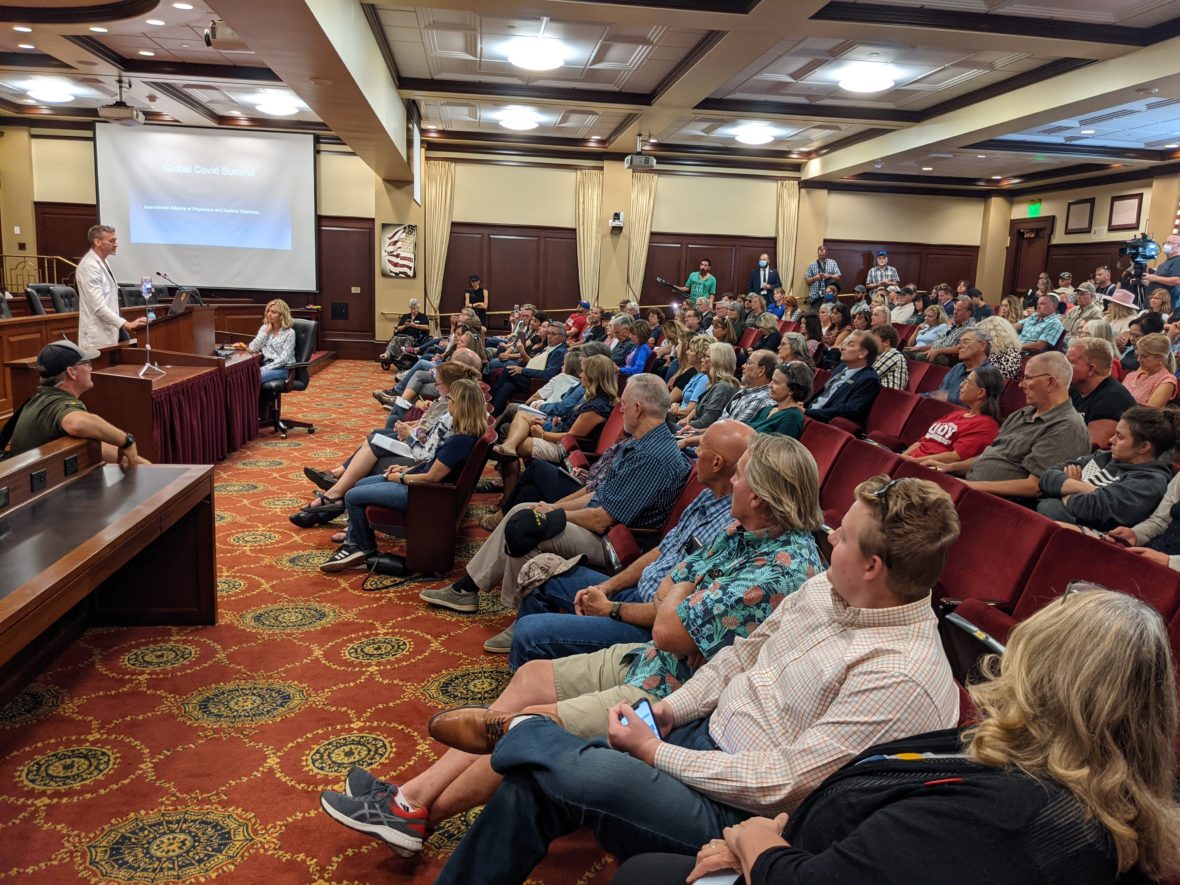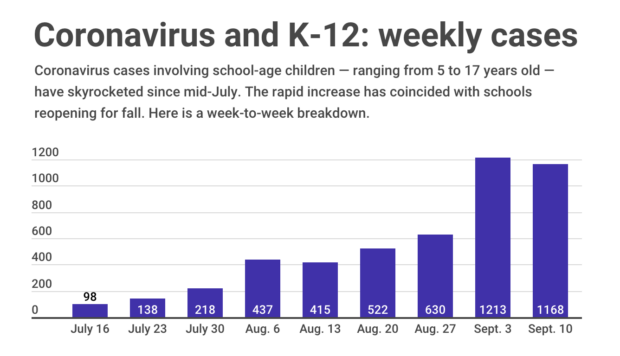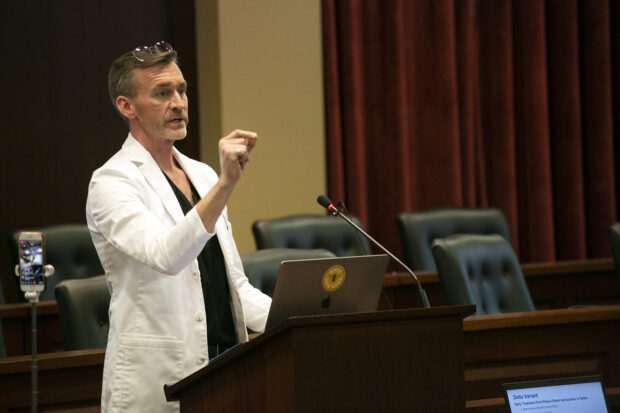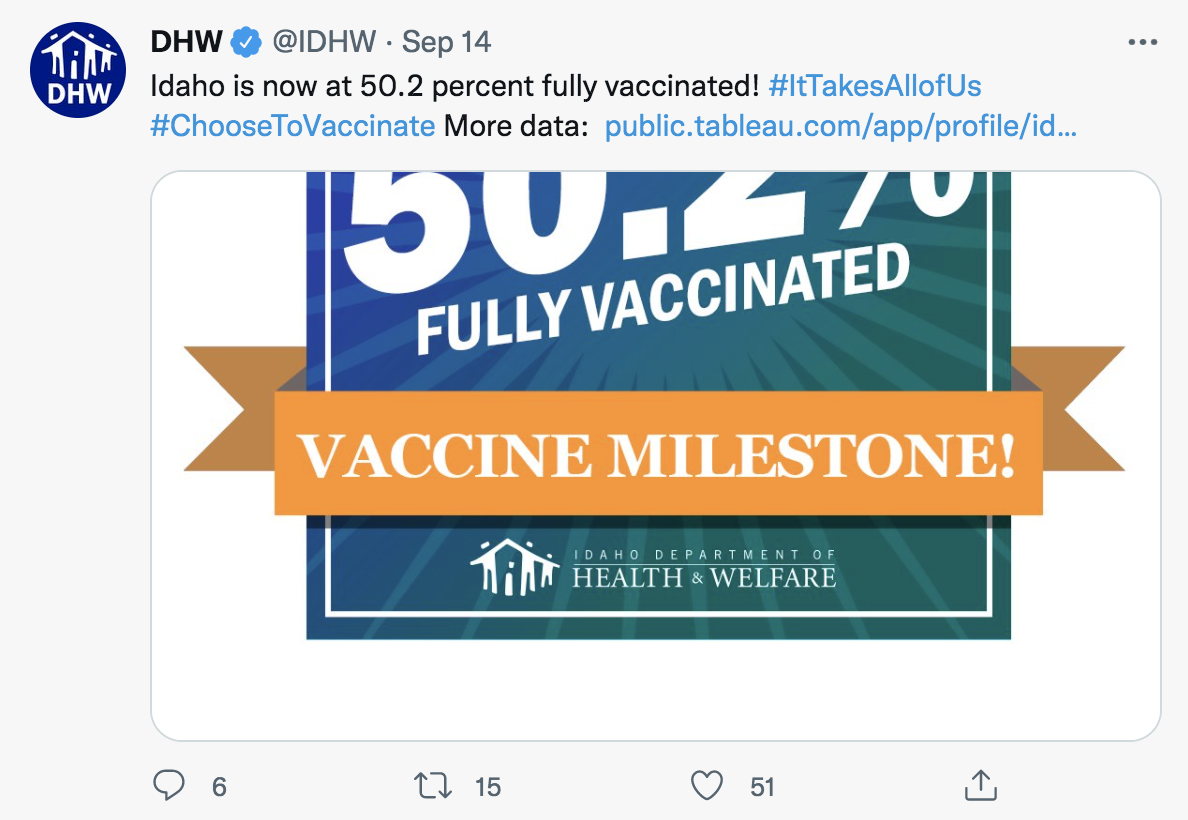
Idaho is entering a new, alarming phase of the coronavirus pandemic, yet Idahoans are still mired in the same old fights.
Deadlocked over vaccines. Gridlocked over masks.
Nothing much changes in the rhetoric. But so much is changing in our hospitals and in our schools — and for the worse:
- On Thursday, the state moved all hospitals into crisis standards of care — rationing that will directly affect patients, whether they have COVID-19 or not. The move was all but inevitable. North Idaho hospitals went into crisis standards of care on Sept. 7. Just six days later, statewide COVID-19-related hospital admissions have climbed by another 16 percent, reaching a pandemic peak of 683.
- As the delta variant spreads — largely among unvaccinated Idahoans — children are at increased risk. New case numbers for 13- to 17-year-olds peaked last week, and are increasing more rapidly than any other age group, deputy state epidemiologist Kathryn Turner said Tuesday. Case numbers for 5- to 12-year-olds are increasing almost as rapidly, she said.
- As the delta variant tightens its grip on Idaho’s hamstrung health care system, the path of the pandemic has palpably changed. From March 2020 through Sept. 1, school-aged children accounted for 10 percent of Idaho’s case numbers. Since Sept. 1, that number has swelled to 18 percent. And the new school year is barely under way. During a media briefing on Sept. 7 — the day North Idaho hospitals entered crisis standards of care — Kootenai Health critical care Chief of Staff Robert Scoggins said his overwhelmed colleagues are bracing for another gutwrenching possibility: treating an ever-younger group of critically ill patients.
Despite all the bad news on top of bad news, the talking points haven’t budged much.
 State leaders are staying on message — urging vaccine-resistant Idahoans to get the jab, and encouraging everyone to step up their masking and social distancing. There’s always something to be said for consistency, especially when the science supports the message.
State leaders are staying on message — urging vaccine-resistant Idahoans to get the jab, and encouraging everyone to step up their masking and social distancing. There’s always something to be said for consistency, especially when the science supports the message.
But the message sounds weary — as if it is shouldering the weight of much of our collective COVID fatigue.
Gov. Brad Little talked up the importance of vaccinations during an AARP Idaho virtual town hall Wednesday. He was to a large extent preaching to a jabbed choir; 77 percent of Idahoans over age 65 are fully vaccinated, compared to 44 percent of 12- to 64-year-olds.
But Little still got some pushback, and blinked.
A caller, identifying himself as Fred from Kooskia, repeated the oft-stated claim that the coronavirus vaccines have killed thousands of patients: 14,506, to be exact. He cited the federal government’s own Vaccine Adverse Event Reporting System, or VAERS.
Trouble is, VAERS doesn’t work this way. Before accessing its data, users must click on a disclaimer that says the voluntary reports “may contain information that is incomplete, inaccurate, coincidental, or unverifiable.” Media reports have refuted claims that VAERS data provides proof of thousands of COVID-19 vaccine-related deaths.
Little gave Fred a pass. He said he didn’t question Fred’s statistics, before offering the boilerplate case: The vaccines greatly reduce the risk of a serious COVID case. “The vaccine is vastly superior to everything else.”

Two hours later, Dr. Ryan Cole didn’t lack for energy.
Speaking to his own kind of crowd — nearly 200 people in the Statehouse’s largest committee room, almost all unmasked — the controversial physician and newly appointed Central District Health board member served up 60 minutes of counterpoint. Speaking at the invitation of Lt. Gov. Janice McGeachin, Cole took pains to say he was neither pro-vaccine nor anti-vaccine. But he essentially said the COVID-19 vaccines were ineffective, an attempt to fight the 2021 strain of the coronavirus with treatments targeting the 2020 edition.
“Delta has escaped the shot we’re giving,” said Cole.
Here’s what Idaho’s numbers say. Since May 15, when the vaccines were made fully available to anyone over age 12, unvaccinated Idahoans account for 90 percent of the state’s coronavirus cases, 91 percent of COVID-19 hospitalizations and 88 percent of COVID-19 deaths. A strong pattern, considering that barely half of eligible Idahoans are fully vaccinated.

But it can hardly be a surprise that it took Idaho until this week to finally limp past the 50 percent vaccination rate milestone. Nor should it be a surprise that Idaho’s vaccination traffic has fallen by more than two thirds since April. If the vaccine provides Idaho with its best hope of keeping schools open — the recurring message from Little and other state leaders — then help for schools will be a long time coming.
The vaccine is moving like a cropduster. The delta variant is moving like an F-35.
It’s one thing to argue over vaccines that only became publicly available in December. Idaho still can’t even get it together over masks.
On Monday, a divided Coeur d’Alene board of trustees voted against a school mask mandate, despite the crisis standards of care in effect in area hospitals. Victor Elementary School closed its doors for the week — due to a variety of illnesses, but also days after the school district decided to go against Victor’s municipal mask mandate.
And in the higher education arena, Boise State University had to admit something that was already clear to anyone who was in Albertsons Stadium Friday night, or anyone watching the Broncos on TV. On a week that saw another 104 coronavirus cases on campus, the university’s gameday mask mandate went over about as well as stale tortilla chips at a tailgate.
“We are aware of and disappointed by the lack of adherence to the current facial covering requirement by many of those in attendance,” Boise State said in an email to season ticketholders, pledging to offer prizes to fans who mask up.
Department of Health and Welfare officials have stayed on message for weeks: They are urging people to wear masks indoors and in crowded outdoor settings. They’ve been consistent, but hardly forceful. It’s still up to school districts to require mask usage — or not. And when asked Tuesday about the masking issues at Albertsons Stadium, top Health and Welfare officials did not criticize Boise State.
Nineteen months into the pandemic, we’re still talking about the same things. Vaccines and masks.
But Idaho’s hospitals are facing an unprecedented calamity. As health care professionals face the heartwrenching prospect of rationing treatments, school officials are trying to figure out how to keep kids in the classroom — as more and more of them are coming down with the coronavirus.
Meanwhile, state leaders sound tired, at the worst possible time. An urgent situation calls for an urgency of message.
Each week, Kevin Richert writes an analysis on education policy and education politics. Look for his stories each Thursday.
Republish this article on your website
Republican state representatives descended on the House floor after rallying anti-vaccine-mandate protesters on the steps of the State Capitol Wednesday.
So why do we continue to struggle to provide these programs to all the primary age students in Idaho?
When school employees feel undervalued and unsafe, particularly by their own leadership and communities, they will start to opt themselves out of this career.
I am exhausted, hurt, and sad that this may be my last year as a teacher.
Chose to receive the vaccine and wear face masks while attending events. The science shows that both make a difference.
"time" - Google News
September 17, 2021 at 03:31AM
https://ift.tt/3Ajk3PY
Analysis: State leaders sound tired, at the worst possible time - Idaho EdNews
"time" - Google News
https://ift.tt/3f5iuuC
Shoes Man Tutorial
Pos News Update
Meme Update
Korean Entertainment News
Japan News Update
Bagikan Berita Ini














0 Response to "Analysis: State leaders sound tired, at the worst possible time - Idaho EdNews"
Post a Comment